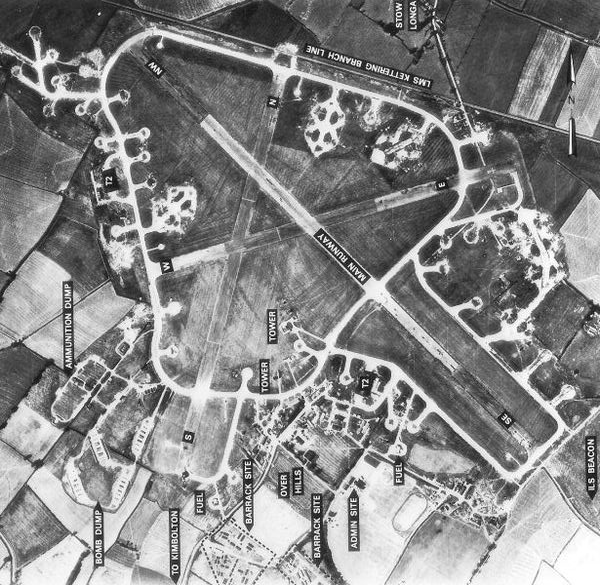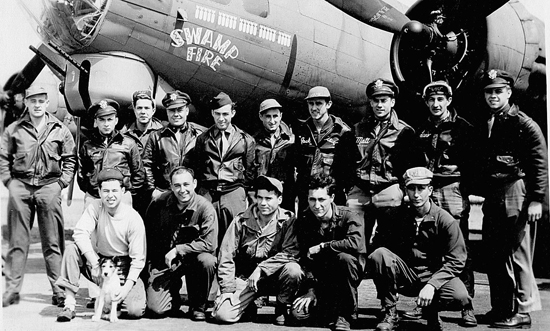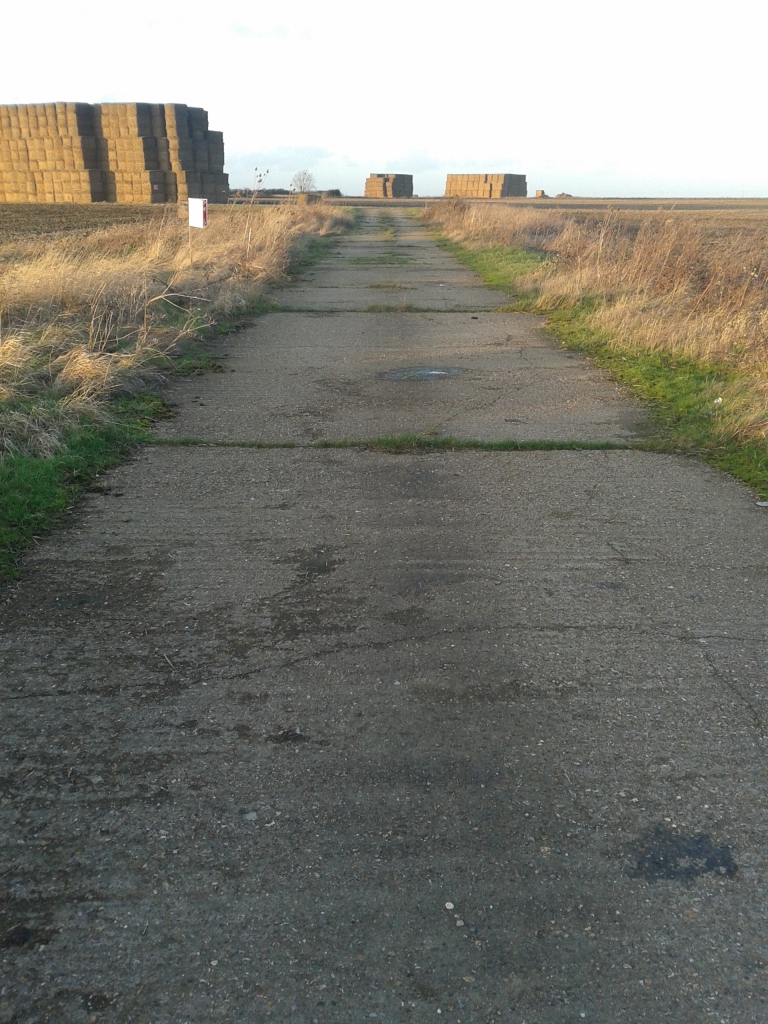A few miles west of Huntingdon, Cambridgeshire, between the villages of Stow Longa and Kimbolton, rests a flat, windswept area of farmland that the B-road snakes across. One can easily miss the short stretch of narrow road that cuts across the older, crumbling concrete of class-A taxiways that once carried B-17 Flying Fortresses to the main northwest-southeast runway. If you stop and trudge out across the muddy public footpath which heads due west, you will come across patches of concrete, often covered in hay bales for the local livestock. It is an eerie scene, for one cannot help but picture the heavy bombers combing back from a mission deep over Germany, and in the strong winds that blow across the flat fields, one can almost hear the engines of the bombers.

These flat fields with their small patches of runway and tarmac are all that remain of Royal Air Force Station Kimbolton, a Class A airfield used by the U.S. Army Air Forces’ Eighth Air Force from 1942 through the end of the Second World War. First the 91st Bomb Group (Heavy) arrived in 1942 and began operations from RAF Kimbolton but had to move off the field quickly as the runways were determined neither strong nor long enough for the heavy bomb loads the B-17s carried. Until the runways could be improved, the 17th Bomb Group (Medium) used the field, flying the Martin B-26 Marauder, from October of 1942 until the group departed for North Africa. With 17th Bomb Group’s departure, the main runway was strengthened and extended, as is visible in this aerial photo of the base taken on 10 August 1945 shows:

Then came the 379th Bomb Group (Heavy), with its famous “triangle-K” markings on the vertical stabilizers of the B-17s, which would operate from RAF Kimbolton until the end of the war. Four squadrons: the 524th, 525th, 526th and 527th Bombardment Squadrons comprised the 379th which flew its first combat mission on 19 May 1943. Focused on the war-making capabilities of Germany, the 379th flew raids on heavy industry, refineries, warehouses, submarine pens, airfields, marshalling yards and command and control centres across occupied Europe. They flew bombing missions against the ball-bearing plants at Schweinfurt and Leipzig, against synthetic oil plants at Merseburg and Gelsenkirchen, against the chemical plants at Ludwigshaven and airfields from Occupied France to Berlin.

On 11 January 1944, the 379th attacked aircraft factories deep in Germany without fighter cover, earning the unit the coveted Distinguished Unit Citation. Before D-Day, the group focused on strong fixed positions, rail transfer and choke points, and gun batteries: softening up the Atlantic Wall before the greatest amphibious invasion in history.

The B-17G Serial # 42-32024, named the “Swamp Fire” famously flew 100 missions without a single abort – an unheard of accomplishment during the war from RAF Kimbolton. Forty different crews took the plane on her missions over occupied Europe and Germany. According to the Swamp Fire website, where veterans who flew on her during the war post memories and photos, a joke around the base in October 1944 was that: “After a new nose and tail section, a new ball turret, 16 engine changes, three wing replacements and over 1,000 bullet and flak hole patches, there is not much of the original plane left.” However, in a ceremony for the aircraft after her 100th mission, the Commanding Officer of the 379th, Colonel Lewis Lyle said: “No, there isn’t much of the original Swamp Fire, just the fighting spirit and tradition built into her and maintained by her ground and combat crewmen. She is an excellent criterion of the greatest bomber in the European Theatre of Operations.”

The 379th Bomb Group holds the record for the most tonnage dropped of any U.S. Army Air Force Bomb Group operating from the United Kingdom – 26,459 tons of ordnance. The 379th holds the record for most missions flown: 330 between May 1943 and May 1945. In June 1945, the 379th transferred from RAF Kimbolton and the base was closed temporarily. From the late 1940s until the early 1960s, the Royal Air Force used the base for basic training of new recruits before it was finally closed, dismantled and returned to agricultural use.


The 379th Bomb Group (Heavy) maintains an excellent archive at: http://www.379thbga.org/
Thanks to the Swampfire website for research and photographs, please visit at: https://sites.google.com/site/swampfiresite/


My father, William May Johnson was stationed at Kimbolton prior to going to North Africa. I wish to thank you for the recondition you have given to the Yanks who once served at Kimbolton.
I grew-up hearing about England and Kimbolton. My father was a anglophile. He was an artist. I couldn’t find his name listed under the 379th Bomber Group. This suggests there were other unites at Kimbolten. I heard artist were used during WWII to create camouflage and to throw off the enemy.
Thanks.
Michael Johnson
LikeLike
Michael,
Thanks for your comment – I think your father, William May Johnson, may have served in the 17th Bomb Group (Medium). That unit was stationed at RAF Kimbolton before the 379th Bomb Group (Heavy). The 17th flew the Martin B-26 Marauder medium bomber, and used Kimbolton as a transitory airfield on its way to the North African campaign. The Group departed RAF Kimbolton for Telergma, Algeria, with its last elements leaving in early December 1942. Do those dates fit with your father’s time there? If so, the 17th Bomb Group maintains a pretty impressive website, with some excellent photographs of B-26s operating in North Africa: http://www.bombgroup17.com/home.
Thanks again Michael!
LikeLike
I just returned from my 4th visit to the 379th Bomb Group Air Field at Kimbolton, England.
I served there in 1944 with the 527th squadron and our crew was assigned to fly the first new B-17 G model that arrived at our base. Our ground crew chief (Pete Jabor) named the plane Snow White as it was not painted and at first and we stood out like a sore thumb with all the painted group formation. We flew Snow White for 15 of our missions and then had a 48 hour pass to London and another crew was shot down on Snow White’s 16th mission. On one of our missions with her we took three direct 88 hits and one of two times she had to go in for major repairs.
I was the flight engineer and also trained to fly it if needed.
We flew 36 missions and did not get credit for going in at the Cherborg Peninsula to help our troops break out through German lies. We were the first group in, bombing by smoke signal the line of our troops and were on our way back to base when mission the was scrubbed as General McNair and his forward Command post were all killed when smoke drifted over the post and a twin-engine bomber hit them by mistake.
LikeLike
Teddy, I’d love to bend your ear and hear some more stories of missions flown from RAF Kimbolton. Thanks for your comment and I’m very glad you made it through almost 80 years ago.
LikeLike
Hello Teddy,
Good to hear from you.
My cousin, S/SGT Raymond Samuel Heron, flew with the 379th BG 526th BS (42-5839).
(Apr–June 1943). Doing a real lot of research into the full crew and have discovered some very interesting ‘things’.
Tell me, was/is it an unwritten moral code for both allied and enemy fighter pilots to NOT shoot down parachutists once they had bailed out?
Peter
LikeLike
Awesome blog you have here
LikeLike
I flew combat B52G’s as an EWO out of Wurtsmith AFB from the middle 70’s to early 80’s with the 524th BMS, 379 BMW. I very much enjoyed looking at your site for the 524 BS 379 BG
LikeLike